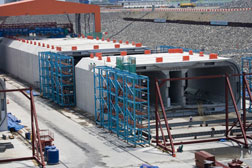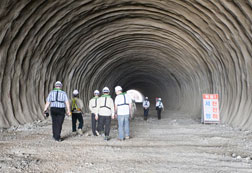 Michael Goodman/ENR Tunnel boxes are 26.5 m x 10 m, to be sunk to 47 m below sea level.
|
Concrete troubles threw the 8.2-kilometer-long Busan-Geoje fixed-link project off-course early on. But now the contractor is investing in extra equipment and precast piers are emerging from the choppy waters.
With its deep, sunken-tube tunnel, multiple cable-stayed spans and exposed ocean site, the privately financed project will create the sole road link from South Korea's second-largest city, Busan, to Geoje Island, a shipbuilding and tourism hub.
 Michael Goodman/ENR Transitory tunnels take route through islets and onto bridge.
|
A consortium of Korean contractors, led by Daewoo E&C Co. Ltd., is building the estimated $1.4-billion project under a 40-year build-transfer-operate contract with Busan city and the province. Six years of turnkey construction are due to end in 2010.
From Gaduk Island, already linked to the mainland, the project extends westward to Geoje via three islets. The first section from Gaduk consists of a 3.24-km-long twin-box sunken-tube tunnel in a trench. The trench descends to 47 m below sea level, one of the world's deepest.
The tunnel makes its transition to the first, 1.9-km elevated section at the twin islets of Jungjuk and Daejuk through a cut-and-cover tunnel, open ramp and twin rock tunnels. The cable-stayed section of this stretch has a 475-m main span and pylons rising 156 m above caissons. West of the bridge, the link runs for some 700 m through Jeo Island before rising onto the 2.4-km-long second bridge, with twin 230-m-long navigation spans.
|
Primarily Precast
The elevated sections are founded on caissons, with piles used in only two places because good ground was too deep. The diamond-shaped pylons with curved legs will be jump-cast on site, but otherwise the project consists mostly of precast elements.
Work started in December 2004 at the 29-hectare Anjeon dry dock, a towing distance 35 km away. All major elements will be precast there and transported to the crossing, some by a 3,000-tonne floating crane. Currently, construction of the first four tunnel elements dominates the yard.
 |
The contractor is casting the 26.5-m-wide, 10-m-deep boxes, with 1.3-m outer walls, in eight segments. These are stressed together through double-water-proofed joints into 180-m elements. Each segment is cast in one pour of over 2,200 cu m to eliminate joints.
Because of early snags, reportedly causing nine months' delay, the contractor is expanding the yard and procuring another set of molds. That investment will reduce the number of dock floodings needed from five to four, explains Sung Bae Park, the contractor's general manager. "They had some starting-up problems, but you see that in every part of the world," adds Kent Fugslang, a senior site adviser with the turnkey contractor's designer, Cowi A/S, Copenhagen.
 |
Having first built a quarter-size pilot segment, "we had to take the Korean workers from the trial casting to the real world," says Don Fraser, a special adviser with London-based Halcrow Group. Halcrow, in joint venture with TEC Engineering Consultants of the Netherlands, is providing specialist advice to the contractor. "So we had some concrete placing problems." Concrete faults were superficial and easily remedied "but didn't look very good," adds Fraser. The poor concrete quality of the first element caused authorities to order a precautionary membrane to be applied. Cowi's design had omitted a membrane, relying on crack-free concrete to keep water out, says Tommy Olsen, one of the firm's site advisers. Officials are currently considering various spray-on membrane options.
 |
The first tunnel elements will be floated out after the dry dock is flooded for the first time this October. They will be moored offshore and placed during the weather window, ending next March, says Fraser. Founded on clay, the tunnel will be prone to settlement so the contractor is improving the soil with deep cement mixing and surcharging, says Cowi's Olsen.
| + click to enlarge |
 Highway between Busan and Geoje passes through Gaduk Island.
|
At a smaller yard on Geoje Island, the contractor is casting concrete road slabs onto 90-m-long deck sections of the bridge's approach spans. The deck comprises three, 3.6-m- deep, cross-braced steel I-girders. A floating shear leg crane will start placing the sections this October. Decks for the cable-stayed deck elements, with 2-m-deep girders, will be cast after they are placed, in balanced, stay-supported cantilevers.
As the project beds down and construction gets out of the water, the outcome should be more predictable. But "this is wide-open sea, and that makes the project rather special, particularly for the tunnel," say Fraser. "You get some very high winds."
 Related Link:
Related Link: 
Post a comment to this article
Report Abusive Comment